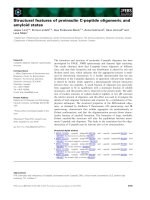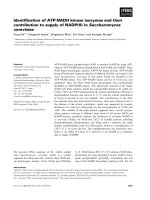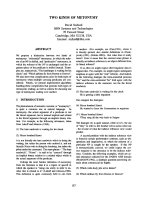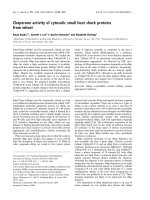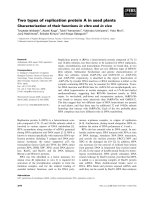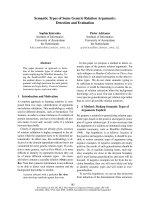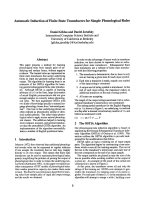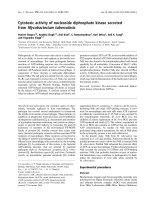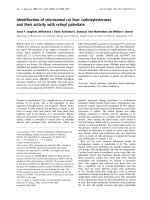Báo cáo khoa học: Two types of replication protein A in seed plants Characterization of their functions in vitro and in vivo ppt
Bạn đang xem bản rút gọn của tài liệu. Xem và tải ngay bản đầy đủ của tài liệu tại đây (463.74 KB, 12 trang )
Two types of replication protein A in seed plants
Characterization of their functions in vitro and in vivo
Toyotaka Ishibashi
1
, Asami Koga
1
, Taichi Yamamoto
1
, Yukinobu Uchiyama
1
, Yoko Mori
1
,
Junji Hashimoto
2
, Seisuke Kimura
1
and Kengo Sakaguchi
1
1 Department of Applied Biological Science, Faculty of Science and Technology, Tokyo University of Science, Japan
2 National Institute of Agrobiological Sciences, Ibaraki, Japan
Replication protein A (RPA) is a heterotrimeric com-
plex composed of 70, 32 and 14-kDa subunits which is
involved in various aspects of DNA metabolism [1].
RPA accumulates along stretches of ssDNA generated
during DNA replication and DNA repair [2–5]. RPA is
known to interact specifically with numerous DNA rep-
lication proteins: including T antigen and DNA poly-
merase a-primase; the tumor suppressor p53; the
transcription factors Gal4 and VP16; the DNA repair
proteins XPA, DDB, XPF, XPG, uracil DNA glycosy-
lase, Rad52, and Rad51; and the DNA helicases,
Bloom’s and Werner’s proteins.
RPA was first identified as a factor necessary for
simian virus 40 replication in vitro. It is required for
activation of the prereplication complex to form the
initiation complex, and for the ordered loading of
essential initiator functions, such as the DNA poly-
merase a-primase complex, to origins of replication
[6–9]. Furthermore, during strand elongation, RPA sti-
mulates the action of DNA polymerase a¢, d and e.
RPA also has essential roles in DNA repair. In nuc-
leotide excision repair, RPA interacts with XPA at sites
of DNA damage, stimulates XPA–DNA interaction,
and recruits the incision proteins ERCC1 ⁄ XPF and
XPG to the damaged site [10–12]. In addition, RPA
was necessary for the removal of oxidized base lesions
from genomic DNA in long-patch base excision repair
[13,14]. In the repair of double-strand breaks by homo-
logous recombination, RPA greatly stimulates DNA
strand exchange by Rad51 protein, provided that RPA
is added to a pre-existing complex of Rad51 protein
and ssDNA. When double-strand breaks occur in
DNA, RPA binds and protects exposed ssDNA ends
until they can be coated by Rad51. RPA then catalyzes
Keywords
Arabidopsis; DNA repair; DNA replication;
replication protein A; rice
Correspondence
K. Sakaguchi, Department of Applied
Biological Science, Faculty of Science and
Technology, Tokyo University of Science,
2641 Yamazaki, Noda-shi, Chiba-ken 278-
8510, Japan
Fax: +81 4 7123 9767
Tel: +81 4 7124 1501 (ext. 3409)
E-mail:
(Received 20 January 2005, revised 18
March 2005, accepted 15 April 2005)
doi:10.1111/j.1742-4658.2005.04719.x
Replication protein A (RPA), a heterotrimeric protein composed of 70, 32
and 14-kDa subunits, has been shown to be essential for DNA replication,
repair, recombination, and transcription. Previously, we found that, in two
seed plants, rice and Arabidopsis, there are two different types of RPA70-
kDa subunit. Substantial biochemical and genetic characterization of
these two subunits, termed OsRPA70a and OsRPA70b or AtRPA70a
and AtRPA70b, respectively, is described in this report. Inactivation of
AtRPA70a by transfer DNA insertion or RNA interference is lethal, so the
complex containing RPA70a may be essential for DNA replication. Trans-
fer DNA insertion and RNAi lines for AtRPA70b are morphologically nor-
mal, albeit hypersensitive to certain mutagens, such as UV-B and methyl
methanesulfonate, suggesting that RPA70b functions mostly in DNA
repair. In two-hybrid, pull-down and coexpression analysis, OsRPA70b
was found to interact more selectively than OsRPA70a with OsRPA32.
The data suggest that two different types of RPA heterotrimer are present
in seed plants, and that there may be additional 32 and 14-kDa subunit
homologs that interact with OsRPA70a. Each of the two probable plant
RPA complexes may have different roles in DNA metabolism.
Abbreviations
GST, glutathione S-transferase; MMS, methyl methanesulfonate; RPA, replication protein A.
3270 FEBS Journal 272 (2005) 3270–3281 ª 2005 FEBS
the homologous pairing and strand-exchange steps of
homologous recombination (HR) [15–17].
The 32-kDa subunit of RPA is phosphorylated dur-
ing the progression of cells from G1 to S phase and
hyperphosphorylated in response to a wide variety of
DNA-damaging agents, such as ionizing radiation, UV,
and camptothecin [18–21]. The RPA phosphorylation
stimulated by DNA damage promotes DNA binding
and chromatin association of ATR (ataxia telangiecta-
sia-mutated and Rad3-related) in vitro via ATR inter-
acting protein [4,22,23]. Rad17 and Rad9 complexes
(Rad17–RFC2–5 and Rad9–Rad1–Hus1) play a crucial
role in the activation of the ATR-mediated DNA
damage and DNA replication stress response pathway.
RPA is also required to recruit and activate Rad17
complexes for checkpoint signaling in vivo. It may func-
tion in the sensing of DNA damage [22].
In contrast with the intensive study of RPA in ani-
mals and yeast, little is known about this protein in
plants. In 1997, an ortholog of the RPA70-kDa subunit
(OsRPA1) was isolated from deepwater rice (Oryza
sativa L. cv. Pin Gaew 56), and its expression was
found to be induced by gibberellin [24]. Unexpectedly,
we found that rice has two different types of RPA70-
kDa subunit, termed OsRPA70a and OsRPA70b,
respectively [25]. Northern blot analysis revealed differ-
ent expression patterns for these two subunits, indica-
ting that they may perform different functions [25].
OsRPA70a is expressed in proliferating tissues that con-
tain meristems, such as root tips and young leaves, but
also more weakly in mature leaves; OsRPA70b is
expressed mostly in proliferating tissues [25].
Arabidopsis thaliana also has two different types of
RPA70-kDa subunit, suggesting that two RPA70-kDa
subunits are universally present in seed plants [25].
Given that OsRPA70a and OsRPA70b may have differ-
ent functions in rice, the presence of two subunit types
in A. thaliana raises the possibility that these proteins
have become functionally specialized in all seed plants.
Here, we report biochemical differences between
OsRPA70a and OsRPA70b, and genetic differences
between the A. thaliana homologs of OsRPA70a and
OsRPA70b (AtRPA70a and AtRPA70b), revealed using
transfer DNA (T-DNA) insertion and RNA interfer-
ence (RNAi) mutants.
Results
cDNAs of OsRPA70a, OsRPA70b, OsRPA32 and
OsRPA14
The cloning of the rice homologs of t he RPA subunits,
OsRPA70a, OsRPA70b,andOsRPA32, has been des-
cribed [25]. Here, we cloned a cDNA for the rice homolog
of the RPA 14-kDa subunit (OsRPA14), which was not
reported earlier. Each gene was found to exist as a single
copy per genome by Souther n blotting analysis (data not
shown). Nucleotide sequence data for OsRPA70a,
OsRPA70b, OsRPA32 and OsRPA14 are d eposited in the
DDBJ ⁄ EMB L ⁄ GenBank nucleotide sequence databases
with the accession numbers AB042415, AB111916,
AB037145, and AB111915, respectively. As antibodies
against OsRPA70a and OsRPA70b showed cross-reactiv-
ity, each antibody was purified by s ubtractive affinity puri-
fication (data n ot shown).
Analysis of T-DNA insertion mutants and RNAi
mutants of A. thaliana homologs of OsRPA70a
and OsRPA70b (AtRPA70a and AtRPA70b)
A. thaliana was used for genetic analysis of the functions
of OsRPA70a and OsRPA70b because it has closely rela-
ted homologs (AtRPA70a and AtRPA70b, respectively)
and because many T-DNA insertion mutants of A. thali-
ana are already available [26]. We were able to obtain
one T-DNA insertion line each for AtRPA70a and
AtRPA70b (Fig. 1A). The T-DNA insertion in
AtRPA70a (atrpa70a) was lethal, but the AtRPA70b
T-DNA insertion mutant (atrpa70b) was viable (Table 1)
and did not differ in phenotype from the wild-type.
To confirm these mutant phenotypes, A. thaliana
lines were generated in which AtRPA70a or AtRPA70b
was inactivated by an RNA interference method
(RNAi). The RNAi mutant of AtRPA70a also showed
lethality (data not shown). On the other hand,
AtRPA70b RNAi mutant lines were viable, and did
not differ in phenotype from wild-type. We performed
RT-PCR analysis with a total RNA extract from seed-
lings of atrpa70b, and confirmed that AtRPA70b was
not expressed (Fig. 1B). As a control, S16 ribosomal
protein was also analyzed to normalize for both the
amount of input RNA for the RT reaction and the
efficiency of the PCR (Fig. 1B). We performed West-
ern blot analysis of total proteins from seedlings of
wild-type, atrpa70b, and the AtRPA70b RNAi mutant,
and confirmed that very little AtRPA70b protein is
present in the mutants (Fig. 1C).
These results indicated that RPA70a has an essential
role, probably in DNA replication, whereas RPA70b is
not essential under normal growth conditions. However,
it is known that yeast rpa70 mutants are very sensitive
to mutagens such as UV and methyl methanesulfonate
(MMS) [27]. To determine whether RPA70b is similarly
involved in mutagen tolerance, the mutagen sensitivity
of atrpa70b and the AtRPA70b RNAi line was tested.
When one-week-old seedlings were exposed to various
T. Ishibashi et al. Two types of RPA in seed plants
FEBS Journal 272 (2005) 3270–3281 ª 2005 FEBS 3271
UV-B doses and then grown for an additional week in
the absence of UV-B, there were no remarkable mor-
phological differences between wild-type, atrpa70b, and
AtRPA70b RNAi mutant seedlings, although leaf
yellowing was somewhat increased in the mutant seed-
lings (Fig. 2A,B). Compared with wild-type, the
amounts of chlorophyll (a + b) were decreased in
atrpa70b and the AtRPA70b RNAi mutant (Fig. 2B).
One-week-old seedlings were also grown on Murashige
and Skoog (MS) medium containing various concentra-
tions of MMS (Fig. 2D,E) or H
2
O
2
(Fig. 2F,G). After
1 week, growth of the wild-type plants was inhibited by
10 000 and 20 000 JÆm
)2
of UV-B (Fig. 2A)2C), by 25,
50, and 75 p.p.m. MMS (Fig. 2D,E), and by 0.1, 1, and
2mm H
2
O
2
(Fig. 2F,G). Compared with the wild-type
plants, the growth of atrpa70b and AtRPA70b RNAi
mutant seedlings was more inhibited by 10 000 and
20 000 JÆm
)2
of UV-B (Fig. 2A,C), and was completely
stopped by 50 and 75 p.p.m. of MMS (Fig. 2D,E). On
the other hand, the mutants showed little increase in
sensitivity to H
2
O
2
(Fig. 2F,G). Like the yeast rpa70
mutants, atrpa70b and the AtRPA70b RNAi mutant are
more sensitive than wild-type to UV and MMS, suggest-
ing that RPA70b is involved in the repair system for
DNA damaged by these mutagens.
Interactions among OsRPA subunits
We investigated the interaction between OsRPA sub-
units using yeast two-hybrid analysis (b-galactosidase
assay) (Fig. 3A) and an in vitro pull-down assay
(a protein–protein interaction assay) (Fig. 3C–E). In
the two-hybrid assay, the interaction between
OsRPA70a and OsRPA32 yielded about 20% of the
relative activity of the OsRPA32 and OsRPA14 interac-
tion. The interaction of OsRPA70b and OsRPA32
yielded about 75% of the relative activity of the
OsRPA32 and OsRPA14 interaction. The controls
(interaction with BK vector alone) yielded very little
b-galactosidase activity. Western analysis showed that
OsRPA70a and OsRPA70b were expressed in approxi-
AB
C
Fig. 1. Analysis of AtRPA70 T-DNA insertion and RNAi mutant lines. (A) Disruptions of AtRPA70a and AtRPA70b by T-DNA insertion. Gray
rectangles represent the coding region. The short arrows indicate primers used for RT-PCR of AtRPA70b: 70b F1, 70b F2, 70b R1, and 70b
R2. (B) Expression of mRNA in wild-type and the AtRPA70b T-DNA insertion mutant (atrpa70b), as measured by RT-PCR. Lane 1, wild-type
(Columbia); lane 2, atrpa70b. Upper and middle rows indicate AtRPA70b, and lower row indicates S16 ribosomal protein as a control. (C)
Expression of protein in western blot analysis using antibodies to OsRPA70b. Lane 1, wild-type (Columbia); lane 2, atrpa70b; lane 3,
AtRPA70b RNAi mutant.
Table 1. Genotypes of atrpa70a and atrpa70b. Genomic DNA was
extracted from leaves of F2 seedlings from AtRPA70a and
AtRPA70b heterozygous T-DNA insertion mutants (F1), and subjec-
ted to PCR analysis. Genotypes were scored as homozygous wild-
type (amplification observed only with gene-specific primers),
T-DNA insertion heterozygous (amplification observed with both
sets of primers), or T-DNA insertion homozygous (amplification
observed only with the T-DNA ⁄ gene-specific primer pair).
F2
(+) ⁄ (+) (+) ⁄ (–) (–) ⁄ (–)
F1
AtRPA70a(+) ⁄ (–) 14 34 0
AtRPA70b(+) ⁄ (–) 12 23 11
Two types of RPA in seed plants T. Ishibashi et al.
3272 FEBS Journal 272 (2005) 3270–3281 ª 2005 FEBS
mately the same amounts in yeast (Fig. 3B), indicating
that the weaker interaction seen for OsRPA70a was
not due to lower OsRPA70a protein levels. Taken
together, the results indicate that OsRPA70b interacted
more strongly with OsRPA32 than did OsRPA70a
(Fig. 3A). Neither OsRPA70a nor OsRPA70b interac-
ted with OsRPA14 directly (data not shown).
In vitro pull-down assays were performed using
the following protein pairs: T7 tag-OsRPA70a and
OsRPA32-His tag (Fig. 3C), OsRPA70b-His tag and
F
A B
D
C
E
G
Fig. 2. AtRPA70b mutants are hypersensitive to UV-B and MMS. (A) Hypersensitivity of atrpa70b to UV-B. The UV-B dosage is 10 000 and
20 000 JÆm
)2
. (B) Chlorophyll content of the wild-type, atrpa70b, and AtRPA70b RNAi mutant plants in (A). (C) Root lengths of the wild-type,
atrpa70b,andAtRPA70b RNAi mutant plants in (A). (D) Hypersensitivity of the AtRPA70b mutants to MMS. The MMS concentrations tested
were 25, 50, 75 and 100 p.p.m. (E) Root lengths of the wild-type, atrpa70b, and AtRPA70b RNAi mutant plants in (D). (F) Effect of H
2
O
2
on
the AtRPA70b mutants. The H
2
O
2
concentrations tested were 0, 0.1, 1 and 2 mM. (G) Root lengths of the wild-type, atrpa70b,and
AtRPA70b RNAi mutant plants in (F).
T. Ishibashi et al. Two types of RPA in seed plants
FEBS Journal 272 (2005) 3270–3281 ª 2005 FEBS 3273
T7 tag-OsRPA32 (Fig. 3D), and T7 tag-OsRPA32 and
OsRPA14-His tag (Fig. 3E). Western blots were
probed with T7 monoclonal antibody. OsRPA70b, but
not OsRPA70a, efficiently interacted with OsRPA32
(Fig. 3C,D). OsRPA32 also interacted with OsRPA14
(Fig. 3E).
OsRPA70b, but not OsRPA70a, can form a
complex with OsRPA32 and OsRPA14
The human RPA70-kDa subunit is known to be insol-
uble when expressed in Escherichia coli, whereas the
RPA 32–14 kDa complex may be soluble [28]. When
the human 70-kDa subunit was coexpressed with both
the 32 and 14-kDa subunits, it became soluble. This
resulted from stabilization of the 70-kDa subunit,
which can form a complex with the 32 and 14-kDa
subunits [29]. To test whether plant 70-kDa subunits
show similar properties, we investigated expression of
OsRPA70a or OsRPA70b in the presence of OsRPA32
and OsRPA14 in E. coli. Expressed proteins were puri-
fied first on a Ni–nitrilotriacetate column, then on a
glutathione S-transferase (GST) column, and then the
GST tag was removed by treatment with PreScission
Protease. With this purification scheme, His-tagged
OsRPA70a, OsRPA70b, and OsRPA14 will not be
recovered in the final elution unless they interact
with GST-tagged OsRPA32. Furthermore, unless
OsRPA70a and OsRPA70b interact with OsRPA32,
they will be insoluble, because these proteins were
insoluble when expressed on their own (data not
shown).
The recombinant RPA complex resulting from
OsRPA70b–OsRPA32–OsRPA14 coexpression con-
tained OsRPA70b (Fig. 4A), but that resulting from
OsRPA70a–OsRPA32–OsRPA14 coexpression did not
have OsRPA70a (Fig. 4A). Therefore, OsRPA70b, but
not OsRPA70a, could form a complex with OsRPA32
and OsRPA14 (Fig. 4A). Compared with OsRPA32 and
OsRPA14, the amount of OsRPA70b in the complex
was very small. This imbalance may reflect free
OsRPA32 and OsRPA14, or a complex of OsRPA32
and OsRPA14, in the OsRPA70b–OsRPA32–OsRPA14
extracts (Fig. 4C). A small amount of OsRPA70a recom-
binant protein was found in the soluble fraction of
OsRPA70a–OsRPA32–OsRPA14 extracts but most of it
failed to bind to the GST column (Fig. 4A), indicating
that it could not interact with the OsRPA32 and
OsRPA14 complex. To confirm this selectivity, puri-
fied recombinant RPA complexes from OsRPA70a–
OsRPA32–OsRPA14 or OsRPA70b–OsRPA32–OsRPA14
extracts were passed through a S300 gel-filtration col-
umn, and then the fractions were analyzed by Western
blotting. The results clearly show that the complex from
OsRPA70a–OsRPA32–OsRPA14 extracts did not con-
tain any OsRPA70a (Fig. 4C), whereas that from
OsRPA70b–OsRPA32–OsRPA14 extracts did contain
OsRPA70b (Fig. 4D). These data suggest that seed
plants contain OsRPA70b–OsRPA32–OsRPA14 com-
plexes in vivo, but also imply the existence of other
A
B
C
E
D
Fig. 3. OsRPA32 interacts with OsRPA70b more strongly than with
OsRPA70a. (A) pGBKT7-OsRPA32 was cotransfected into AH109
yeast with pGADT7-OsRPA70a, OsRPA70b, or OsRPA14, and three
independent transformants were isolated for each plasmid pair.
Liquid cultures of each transformant were prepared and tested for
b-galactosidase activity. Shown are the average activity units for
triplicate assays of representative clones for each plasmid pair. (B)
Expression levels of pGADT-OsRPA70a and OsRPA70b were com-
pared by western blot analysis with HA epitope tag antibody. (C–E)
In vitro pull-down analysis. For each experiment, the indicated pro-
teins were incubated together in NaCl ⁄ P
i
containing 250 mM NaCl
at 4 °C for 1 h, and then incubated with Talon beads. The amount
of protein present in the fraction bound to the affinity column was
quantified by western blot analysis with T7 tag monoclonal anti-
body. On each gel, lanes 1 and 2 show the individual input pro-
teins, and lane 3 shows the fraction bound to the Talon beads. (C)
OsRPA70a-T7 mixed with OsRPA32-His. (D) OsRPA70b-His mixed
with OsRPA32-T7. (E) OsRPA32-T7 mixed with OsRPA14-His.
Two types of RPA in seed plants T. Ishibashi et al.
3274 FEBS Journal 272 (2005) 3270–3281 ª 2005 FEBS
molecules, homologous to OsRPA32 and OsRPA14,
that interact with OsRPA70a.
SsDNA-binding activity of OsRPA70b is increased
in the presence of OsRPA32
To determine the functional significance of the inter-
actions among the RPA subunits, we tested the effect
of RPA32 on the ssDNA-binding activity of
OsRPA70a or OsRPA70b in a gel mobility-shift assay
using purified OsRPA70a, OsRPA70b, and OsRPA32
(Fig. 5). Both OsRPA70a and OsRPA70b had
ssDNA-binding activity (Fig. 5A). On the other hand,
OsRPA32 could not bind to ssDNA (Fig. 5C). Pre-
incubation of OsRPA70a and OsRPA70b with their
respective antibodies before the gel shift assay dimin-
ished or eliminated the shifted bands (Fig. 5B). Next,
the effect of OsRPA32 on the ssDNA-binding activity
of OsRPA70a and OsRPA70b was tested (Fig. 5C).
OsRPA32 increased the binding activity of OsRPA70b,
but hardly affected that of OsRPA70a, suggesting that
OsRPA32 is physiologically related to the function of
OsRPA70b.
Discussion
The lethality of the T-DNA insertion and RNAi
mutants of A. thaliana AtRPA70a indicate that this gene
plays an essential role, such as in DNA replication, in
living cells. In contrast, mutants of AtRPA70b were
viable but showed high sensitivity to UV and MMS,
suggesting involvement of AtRPA70b in the repair of
damaged DNA (Figs 1 and 2). Biochemical analysis of
the interactions between the RPA subunits (Figs 3, 4,
and 5) showed that OsRPA70b, but not OsRPA70a,
could interact with OsRPA32 to form a heterotrimeric
complex with OsRPA32 and OsRPA14. In rice, there
is reported to be coregulation of OsRPA70b and
OsRPA32 during the cell cycle and regulation of
OsRPA32 in response to UV [30]. RPA70-kDa has been
reported to be unstable when not in a complex. Because
expression of OsRPA70a was observed at both the
mRNA and protein levels, and because mutants of
AtRPA70a, a homolog of OsRPA70a, were nonviable,
we suggest that the rice genome contains another pro-
tein, distinct from Os32-kDa, that might form a stable
complex with OsRPA70a (Fig. 6).
RPA70-kDa has two RPA ssDNA-binding domains,
DBD-A and DBD-B, located within the central region,
and a third, DBD-C, in the C-terminal region. DBD-A
and DBD-B are the most important regions for bind-
ing of ssDNA, whereas DBD-C has only weak
ssDNA-binding activity. At the N-terminus of RPA70-
kDa is another related and structurally defined DBD
domain, termed DBD-F. DBD-F has been shown to
interact with multiple proteins and to interact weakly
with DNA. In RPA32-kDa, the DBD-D domain is
located in the central region.
In yeast, RPA1 can only bind to the RPA2 ⁄ 3 dimer,
in contrast with our findings which show binding of
OsRPA70b to OsRPA32 (Figs 3 and 4). Trimerization
is mediated by three domains: DBD-C (in RPA70),
DBD-D (in RPA32), and RPA14, which together form
A
B
C
Fig. 4. Coexpression of three subunits of RPA. For coexpression, Os-
RPA70a-His-tag or OsRPA70b-His-tag, combined with OsRPA32-
GST and OsRPA14-His-tag, were cloned into the pet32A vector and
expressed in E. coli at 37 °C for 3 h. (A) SDS ⁄ PAGE analysis of the
proteins at each step of the purification. Lanes 1 and 4, crude
extracts of isopropyl b-
D-thiogalactoside-induced cells; lanes 2 and 5,
eluate from Ni
2+
-chelate column chromatography; lanes 3 and 6, GST
column chromatography through fraction after treatment with
PreScission Protease. Lanes 1, 2 and 3 are OsRPA70a–OsRPA32–
OsRPA14, lanes 4, 5 and 6 are OsRPA70b–OsRPA32–OsRPA14.
Purified sample was separated by SDS ⁄ 14% polyacrylamide gel
electrophoresis, and stained with Coomassie Brilliant Blue (CBB).
(B) OsRPA70a–OsRPA32–OsRPA14 purified sample was loaded on
a S300 gel-filtration column. Eluted fractions were separated by
SDS ⁄ 14% polyacrylamide gel electrophoresis, blotted on to a
poly(vinylidene difluoride) membrane, and probed with OsRPA70a,
OsRPA32 and OsRPA14 antibodies. (C) OsRPA70b–OsRPA32–
OsRPA14 purified sample was loaded on a S300 gel-filtration column.
Eluted fractions were separated by SDS ⁄ 14% polyacrylamide gel
electrophoresis, blotted on to a poly(vinylidene difluoride) membrane,
and probed with OsRPA70b, OsRPA32, and OsRPA14 antibodies.
T. Ishibashi et al. Two types of RPA in seed plants
FEBS Journal 272 (2005) 3270–3281 ª 2005 FEBS 3275
the trimerization core [31]. The DBD-C and DBD-D
regions of rice are quite similar to the Saccharomyces
cerevisiae DBD-C and DBD-D regions. However,
OsRPA14 has only low similarity to ScRPA14. This
sequence divergence may account for the differences in
binding observed between the yeast and rice proteins.
We would like to emphasize that, compared with the
domain homologs of human and yeast RPA70-kDa,
the rice DBD-A and DBD-B domains are more con-
served than DBD-C and DBD-F. This implies that the
primary function of OsRPA70a and OsRPA70b is to
bind DNA, and that this function has been conserved
during evolution, even though the secondary functions
of these proteins may have diverged. OsRPA70a is
expressed not only in actively dividing tissues but also
in ears [25], where replication and recombination of
DNA are occurring. As RPA is an essential factor for
DNA recombination, RPA70a may be presumed to
function not only in the replication of DNA but also
in DNA recombination in the ears. On the other hand,
based on the high expression of OsRPA70b in actively
dividing tissues [24,25], OsRPA70b may function in
DNA repair and DNA replication. In summary, the
results and discussion presented here suggest the very
interesting possibility that there are two forms of RPA
in higher plants which perform different roles in DNA
metabolism.
A
B
C
Fig. 5. Gel mobility-shift analysis. (A) DNA-binding activity of
OsRPA70a and OsRPA70b. OsRPA70a (lanes 2–5) or OsRPA70b
(lanes 6–9) were incubated with ssDNA for 30 min on ice. DNA–
protein complexes were electrophoretically resolved. (B) Gel mobil-
ity-shift assays of no protein (lane 1), 2 l
M OsRPA70a (lanes 2–5)
or OsRPA70b (lanes 6–9) were performed by incubation with
ssDNA after pretreatment with OsRPA70a antibody (lanes 3, 4 and
9) or OsRPA70b antibody (lanes 5, 7 and 8). (C) Gel mobility-shift
assays of 2 l
M OsRPA70a (lanes 3 and 4) or OsRPA70b (lanes 5
and 6) were performed by incubation with ssDNA, in the presence
(lanes 2, 4, 6) or absence (lanes 1, 3, 5) of 2 l
M OsRPA32.
Fig. 6. Model of plant RPA complex.
Two types of RPA in seed plants T. Ishibashi et al.
3276 FEBS Journal 272 (2005) 3270–3281 ª 2005 FEBS
Experimental procedures
Plant materials
Rice plants (O. sativa L. cv. Nipponbare) were grown in a
growth cabinet under a 16-h light ⁄ 8-h dark cycle at 28 °C.
Cells were grown in suspension culture as described [32].
A. thaliana (Columbia) seeds were germinated on MS
medium or soil, and plants were grown in a growth cabinet
under a 16 h light ⁄ 8 h dark cycle at 22 °C.
Cloning of OsRPA14
The rice EST database was searched using the tblastn pro-
gram. One clone (R0618) was identified that encodes a pre-
dicted protein with homology with the 14-kDa subunit of
RPA. The cDNA of this gene, named OsRPA14, was isola-
ted from rice mRNA using the Rneasy Plant Mini kit
(Qiagen, Valencia, USA), and was amplified with the
SuperScript One-Step RT-PCR System (Invitrogen, Carls-
bad, CA, USA). The nucleotide sequence data reported in
this paper appear in the DDBJ ⁄ EMBL ⁄ GenBank nucleo-
tide sequence databases with the accession number
AB111915 for OsRPA14.
Rice genomic DNA was digested with BglII, EcoRI,
HindIII, or XbaI, and the digested DNA resolved on 1%
agarose gels. The restriction fragments were transferred on
to nylon membranes (Hybond-N; Amersham Biosciences,
Piscataway, NJ, USA) according to the manufacturer’s
recommendations. A
32
P-labeled probe was prepared by
random priming of OsRPA14 cDNA (Rediprime II;
Amersham Biosciences). After prehybridization, hybridiza-
tion was carried out at 42 °C for 16 h, followed by two
washes with 6· NaCl ⁄ Cit ⁄ 1% SDS at room temperature
for 15 min, two washes with 2· NaCl ⁄ Cit ⁄ 1% SDS at
65 °C for 15 min, one wash with 0.1· NaCl ⁄ Cit ⁄ 0.1%
SDS at 65 °C for 15 min, and one wash with 0.1· NaCl ⁄
Cit ⁄ 0.1% SDS at 65 °C for 15 min. OsRPA14 was
shown to exist as a single copy per genome (data not
shown).
Production of polyclonal antibody and
immunological analysis
Polyclonal antibodies against OsRPA70a and OsRPA70b
were raised in rabbits using proteins purified as described
above (Overexpression of recombinant OsRPA70a and
OsRPA70b). These antibodies were shown to be cross-
reactive. Therefore, the antibody against OsRPA70a was
depleted of anti-OsRPA70b cross-reactive components by
absorption on Sepharose-bound OsRPA70b. Similarly, the
polyclonal antibody against OsRPA70b was depleted of
anti-OsRPA70a cross-reactive components by absorption
on OsRPA70a. This procedure abolished the cross-reactiv-
ity with other proteins observed in western blot analysis
(data not shown).
The OsRPA14 coding region was cloned into the pET21a
expression vector (Novagen, San Diego, CA, USA) and
transformed into E. coli for protein induction. Extracts pre-
pared from cells induced for 3 h were shown to contain a
six-histidine C-terminal-tagged OsRPA14 fusion protein.
The OsRPA14 protein was purified by His-Bind resin col-
umn chromatography. The purified protein was used for
immunization of rabbits.
Anti-rabbit IgG conjugated with alkaline phosphatase
(Promega) was used as a secondary antibody with nitroblue
tetrazolium and 5-bromo-4-chloro-3-indolyl phosphate as
substrates [33].
A. thaliana T-DNA insertion mutant analysis
A thaliana lines with T-DNA insertions in atrpa70a
(SALK017580) and atrpa70b (SALK088429) were obtained
from The Salk Institute Genomic Analysis Laboratory
(SIGnAL). Insertion mutant information was obtained
from the SIGnAL website ().
One-week-old seedlings were used for UV-B, MMS, and
H
2
O
2
treatments. UV-B lamps (Philips, Eindhoven, Nether-
lands) were used to irradiate A. thaliana seedlings. A. thali-
ana seedlings were exposed to MMS and H
2
O
2
for a week
for sensitivity analysis.
RT-PCR
cDNAs were synthesized using a Superscript II kit (Invitro-
gen) following the manufacturer’s procedures, and used as
templates for PCR, with 70b F1 (ATGGAGAACTCAGT
GACCCAAGATGGTAT) and 70b R1 (AGAATTCTGAG
GTTGAAGAAGCTAGTAA) primers, and 70b F2 (TACT
ATCAGCAGAAGCAATGTGGTGATA) and 70b R2
(TTACTGAGATGTCTTGTTCTTGGAAATGT) primers
for atrpa70b. As a control, A. thaliana putative 40S ribo-
somal protein S16 (At5g18380) was used (5¢ primer:
GGCGACTCAACCAGCTACTGA; 3¢ primer: CGGTAA
CTCTTCTGGTAACGA).
The three-step cycling conditions were: 29 PCR cycles for
AtRPA70b (F1-R1), 35 cycles for AtRPA70b (F2-R2), and
25 cycles for S16, at 94 °C for 30 s, 55 °C for 30 s, and
72 °C for 2 min.
A. thaliana RNAi
Sequences encoding the inverted-repeat RNA were cloned
into the pBE2113 intermediate vector, which contains an
enhanced CaMV 35S promoter, and a nopaline synthase
promoter:neomycin phosphotransferase (Pnos:NPTII) gene
for the selectable marker [34]. A 460-bp section of b-glu-
coronidase (GUS) (1038–1498 bp) was cloned into the
T. Ishibashi et al. Two types of RPA in seed plants
FEBS Journal 272 (2005) 3270–3281 ª 2005 FEBS 3277
vector as the 5¢ and 3¢ arms of the intron. To construct
RNAi transgenic lines for AtRPA70a and AtRPA70b,
gene-specific cDNA fragments were amplified by PCR
using the following primer pairs: AtRPA70a-5¢ (TGT
AACCGAGATGGTCGGCAAC) and AtRPA70a-3¢ (AA
CAGTCATCTTCACTCTTTGT); AtRPA70b-5¢ (TTCAA
CTTTGTACCCATTGAT) and AtRPA70b-3¢ (TTCACCG
CCATTATATACCTTA). These primers were used to
obtain a fragment of 722 bp corresponding to nt 1135–
1857 of the AtRPA70a cDNA (NM_126648), and of
683 bp corresponding to nt 823–1511 of the AtRPA70b
cDNA (NM_120884). The PCR products were cloned
into the intermediate vector. Constructs were introduced
into Agrobacterium tumefaciens strain EHA106, and trans-
formed into wild-type (Columbia) plants by floral infiltra-
tion [35,36]. The transgenic lines were selected on
MS agar medium containing kanamycin, rifampicin, and
chloramphenicol.
Chlorophyll extraction
The concentration of chlorophyll extracted in 80% acetone
was determined as described by Porra et al. [37].
Yeast two-hybrid analysis (b-galactosidase assay)
The coding region of OsRPA32 was fused in-frame with
the GAL4 DNA-binding domain in the pBKDT7 vector.
The cDNAs of OsRPA70a, OsRPA70b, and OsRPA14 were
subsequently cloned into the pGADT7 vector encoding the
GAL4 activation domain. The GAL4 fusion constructs
were transformed into the yeast strain AH109, and cells
were plated on synthetic medium. Transformation was
carried out according to the MATCMAKER Two-Hybrid
System 3 manual (Clontech, Mountain View, CA, USA).
Proteins were extracted from yeast carrying the pGADT7
vector, pGADT7-OsRPA70a+pBKDT7-OsRPA32, and
pGADT7-OsRPA70b+pBKDT7-OsRPA32 using a urea ⁄
SDS method [38].
Yeast transformants were grown in liquid medium over-
night at 30 °C, centrifuged, and resuspended in Z buffer
(60 mm Na
2
HPO
4
.7H
2
O, 40 mm NaH
2
PO
4
.H
2
O, 10 mm
KCl, 1 mm MgSO
4
.7H
2
O pH 7.0). A
600
was determined for
each sample. o-Nitrophenol b-galactoside (4 mgÆmL
)1
) was
added, and, when a medium yellow color had developed,
the reaction was stopped. The A
420
of the supernatants was
determined. To calculate b-galactosidase units, the follow-
ing equation was applied:
U ¼ 1000A
420
=5tA
600
where t represents the time of reaction (min), A
600
repre-
sents the cell density at the start of the assay, and A
420
is a
combination of absorbance by o-nitrophenol and light scat-
tering by cell debris. All the measurements were performed
in triplicate [39,40].
Pull down assay (protein–protein interaction
assay)
T7 tag-OsRPA70a, OsRPA70b-6His tag, T7 tag-OsRPA32,
OsRPA32–6His tag, and OsRPA14–6His tag were obtained
by in vitro translation in wheatgerm extract (Invitrotec)
according to the manufacturer’s procedure. OsRPA70a (or
OsRPA70b) and OsRPA32, or OsRPA32 and OsRPA14
were incubated with Talon beads (Clontech) for 2 h at
4 °C. The beads were washed four times in NaCl ⁄ P
i
buffer
containing 250 mm NaCl and 0.2% Triton X-100, then
eluted in NaCl ⁄ P
i
buffer containing 200 mm imidazole.
After SDS ⁄ PAGE, proteins were blotted on to poly(vinylid-
ene difluoride) membrane and probed with monoclonal
antibody against T7.
Overexpression of recombinant OsRPA70a and
OsRPA70b
The coding regions of OsRPA70a and OsRPA70b were
cloned into the pET24a (OsRPA70a) and pET28a
(OsRPA70b) expression vectors (Novagen). For protein
expression, these constructs were introduced into Rosetta
(DE3) E. coli (Novagen), and the bacteria grown in 300 mL
Luria–Bertani medium. Cells were grown to an A
600
of 0.8,
and isopropyl b-d-thiogalactoside was added to a final con-
centration of 1 mm. Cells were harvested after 3 h by cen-
trifugation at 3000 g for 10 min at 4 °C. Cell pellets were
resuspended in 10 mL ice-cold binding buffer (20 mm
Tris ⁄ HCl pH 7.9, 0.5 m NaCl, 5 mm imidazole, 0.1% Noni-
det P40) and sonicated with 15 bursts of 10 s each. Cell
lysates were centrifuged at 39 000 g for 30 min. Six-histidine
fusion proteins of OsRPA70a and OsRPA70b were present
in the inclusion body fraction, so cell pellets were subjected
to three rounds of resuspension in binding buffer, sonica-
tion, and centrifugation. After three repetitions of this pro-
cedure, the cell pellet was soluble in the presence of 6 m
urea. Soluble fractions were loaded on to columns contain-
ing 10 mL His-Bind resin (Novagen). The columns were
washed with 50 mL binding buffer containing 6 m urea and
then 50 mL wash buffer (20 mm Tris ⁄ HCl, pH 7.9, 0.5 m
NaCl, 20 mm imidazole, 0.1% Nonidet P40, 6 m urea). The
bound proteins were eluted with 30 mL elution buffer
(20 mm Tris ⁄ HCl, pH 7.9, 0.5 m NaCl, 500 mm imidazole,
6 m urea). The eluted proteins were dialyzed against
buffer A (50 mm Tris ⁄ HCl, pH 7.5, 1 mm EDTA, 5 mm
2-mercaptoethanol, 15% glycerol, 0.1% Nonidet P40) with
decreasing concentrations of urea, as follows: 3 m for 1.5 h,
1.5 m for 1.5 h, 0.5 m for 1.5 h, and no urea for 12 h.
RPA complex analysis
RPA complexes were generated in E.coli Rosetta (DE3)
(Novagen). OsRPA70a and OsRPA70b were cloned in
Two types of RPA in seed plants T. Ishibashi et al.
3278 FEBS Journal 272 (2005) 3270–3281 ª 2005 FEBS
pET21a, OsRPA14 in pET28a, and OsRPA32 in pGEX6p-1
(Amersham Biosciences). The regions containing the T7
promoter and the C-terminal His or GST tag were
cloned in pET32a. We made two constructs for coexpres-
sion: OsRPA70a(His)-OsRPA32(GST)-OsRPA14(His) and
OsRPA70b(His)-OsRPA32(GST)-OsRPA14(His). For pro-
tein expression, each construct was introduced into BL21
(DE3) (Novagen), and the transformed bacteria grown in
200 mL Luria–Bertani medium. Cells were grown to an A
600
of 0.8, and isopropyl b-d-thiogalactoside was added to a
final concentration of 1 mm. Cells were harvested after 3 h
by centrifugation at 3000 g for 10 min at 4 °C. Cell pellets
were resuspended in 10 mL ice-cold binding buffer and soni-
cated with 15 bursts of 10 s each. Cell lysates were centri-
fuged at 39 000 g for 30 min at 4 °C. The soluble RPA
complexes of OsRPA70a(His)–OsRPA32(GST)–OsRPA14
(His) and OsRPA70b(His)–OsRPA32(GST)–OsRPA14
(His) were purified through His-Bind and GST–Sepharose
(Amersham Biosciences) columns and treated with PreScis-
sion Protease (Amersham Biosciences) to remove the GST
tags. Purified proteins were loaded on to a HiPrep 16 ⁄ 60
Sephacryl S-300 HR (Amersham Biosciences), using a col-
umn buffer of 50 mm Tris ⁄ HCl, pH 7.5, 0.2 m NaCl, 1 mm
EDTA, 15% (v ⁄ v) glycerol, 0.1% Tween 20, and 5 mm
2-mercaptoethanol.
Gel mobility-shift assay
Binding of OsRPA70a, OsRPA70b, and OsRPA32 to
ssDNA was studied by gel mobility-shift assay. OsRPA70a
and OsRPA70b were purified as described above (Over-
expression of recombinant OsRPA70a and OsRPA70b).
OsRPA32 was purified as described by Ishibashi et al. [25].
32
P-labeled 30-bp single-stranded DNA (2 pmol) was hea-
ted at 95 °C for 10 min and placed on ice immediately. The
DNA was then incubated in 20 lL of a reaction mixture
containing 25 mm Hepes (pH 7.5), 100 mm NaCl, 1 mm
EDTA, 10% (v ⁄ v) glycerol, 0.1% Tween 20, 0.02%
2-mercaptoethanol, 0.5 mg poly(dI–dC), and 0.5 mg salmon
sperm DNA on ice for 5 min. OsRPA70a, OsRPA70b, and
OsRPA32 proteins were then added, and the reaction mix-
ture was incubated for a further 30 min on ice. DNA–pro-
tein complexes were resolved by electrophoresis on 4%
polyacrylamide gels in 100 mm Tris ⁄ borate buffer, pH 8.3,
containing 2 mm EDTA and 2.5% (v ⁄ v) glycerol at 4 °C.
The gels were dried and then autoradiographed.
Acknowledgements
We thank the Rice Genome research Program (RGP)
of Japan for providing the rice EST clone R0618 and
are grateful to the Salk Institute Genomic Analysis
Laboratory for providing the sequence-indexed Arabid-
opsis T-DNA insertion mutants (SALK 017580 and
SALK 088429). We also wish to express our appreci-
ation to Dr Mitsuhara and Dr Ohashi (National Insti-
tute of Agrobiological Sciences) for providing the
pBE2113 vector. This work was supported by a grant
from the Ministry of Agriculture, Forestry and Fisher-
ies of Japan (Rice Genome Project IP-5006) and by a
grant from the Ministry of Education, Science, Sports
and Culture of Japan (Grant-in-Aid for Young Scien-
tists (B), 15770031). This work was also supported by
a grant from Futaba Electronics Memorial Foundation
(Japan), The Asahi Glass Foundation (Japan) and The
Sumitomo Foundation (Japan).
References
1 Iftode C, Daniely Y & Borowiec JA (1999) Replication
protein A (RPA): the eukaryotic SSB. Crit Rev Biochem
Mol Biol 34, 141–180.
2 Wold MS (1997) Replication protein A: a heterotrimeric,
single-stranded DNA-binding protein required for euk-
aryotic DNA metabolism. Annu Rev Biochem 66, 61–92.
3 Raderschall E, Golub EI & Haaf T (1999) Nuclear foci
of mammalian recombination proteins are located at
single-stranded DNA regions formed after DNA
damage. Proc Natl Acad Sci USA 96, 1921–1926.
4 Wang H, Guan J, Perrault AR, Wang Y & Iliakis G
(2001) Replication protein A2 phosphorylation after
DNA damage by the coordinated action of ataxia telan-
giectasia-mutated and DNA-dependent protein kinase.
Cancer Res 61, 8554–8563.
5 Oakley GG, Loberg LI, Yao J, Risinger MA, Yunker
RL, Zernik-Kobak M, Khanna KK, Lavin MF, Carty
MP & Dixon K (2001) UV-induced hyperphosphoryla-
tion of replication protein a depends on DNA replica-
tion and expression of ATM protein. Mol Biol Cell 12,
1199–1213.
6 Hubscher U, Maga G & Spadari S (2002) Eukaryotic
DNA polymerases. Annu Rev Biochem 71, 133–163.
7 Wobbe CR, Weissbach L, Borowiec JA, Dean FB,
Murakami Y, Bullock P & Hurwitz J (1987) Replication
of simian virus 40 origin-containing DNA in vitro
with purified proteins. Proc Natl Acad Sci USA 84, 1834–
1838.
8 Wold MS & Kelly T (1988) Purification and characteri-
zation of replication protein A, a cellular protein
required for in vitro replication of simian virus 40
DNA. Proc Natl Acad Sci USA 85, 2523–2527.
9 Fairman MP & Stillman B (1988) Cellular factors
required for multiple stages of SV40 DNA replication
in vitro. EMBO J 7, 1211–1218.
10 Wakasugi M, Reardon JT & Sancar A (1997) The non-
catalytic function of XPG protein during dual incision
in human nucleotide excision repair. J Biol Chem 272,
16030–16034.
T. Ishibashi et al. Two types of RPA in seed plants
FEBS Journal 272 (2005) 3270–3281 ª 2005 FEBS 3279
11 Buschta-Hedayat N, Buterin T, Hess MT, Missura M &
Naegeli H (1999) Recognition of nonhybridizing base
pairs during nucleotide excision repair of DNA. Proc
Natl Acad Sci USA 96, 6090–6095.
12 Aboussekhra A, Biggerstaff M, Shivji MK, Vilpo JA,
Moncollin V, Podust VN, Protic M, Hubscher U, Egly
JM & Wood RD (1995) Mammalian DNA nucleotide
excision repair reconstituted with purified protein com-
ponents. Cell 80, 859–868.
13 Dianov GL, Jensen BR, Kenny MK & Bohr VA (1999)
Replication protein A stimulates proliferating cell nuclear
antigen-dependent repair of abasic sites in DNA by
human cell extracts. Biochemistry 38, 11021–11025.
14 Otterlei M, Warbrick E, Nagelhus TA, Haug T, Slupph-
aug G, Akbari M, Aas PA, Steinsbekk K, Bakke O &
Krokan HE (1999) Post-replicative base excision repair
in replication foci. EMBO J 18, 3834–3844.
15 Sugiyama T, Zaitseva EM & Kowalczykowski SC
(1997) A single-stranded DNA-binding protein is needed
for efficient presynaptic complex formation by the Sac-
charomyces cerevisiae Rad51 protein. J Biol Chem 272,
7940–7945.
16 Golub EI, Gupta RC, Haaf T, Wold MS & Radding
CM (1998) Interaction of human rad51 recombination
protein with single-stranded DNA binding protein,
RPA. Nucleic Acids Res 26, 5388–5393.
17 Stauffer ME & Chazin WJ (2004) Physical interaction
between replication protein A and Rad51 promotes
exchange on single-stranded DNA. J Biol Chem 279,
25638–25645.
18 Din S, Brill SJ, Fairman MP & Stillman B (1990)
Cell-cycle-regulated phosphorylation of DNA replication
factor A from human and yeast cells. Genes Dev 4, 968–
977.
19 Brush GS & Kelly TJ (2000) Phosphorylation of the
replication protein A large subunit in the Saccharomyces
cerevisiae checkpoint response. Nucleic Acids Res 28,
3725–3732.
20 Binz SK, Sheehan AM & Wold MS (2004) Replication
protein A phosphorylation and the cellular response to
DNA damage. DNA Repair (Amst) 3, 1015–1024.
21 Dutta A, Ruppert JM, Aster JC & Winchester E (1993)
Inhibition of DNA replication factor RPA by p53.
Nature 365, 79–82.
22 Zou L & Elledge SJ (2003) Sensing DNA damage
through ATRIP recognition of RPA-ssDNA complexes.
Science 300, 1542–1548.
23 Unsal-Kacmaz K & Sancar A (2004) Quaternary struc-
ture of ATR and effects of ATRIP and replication
protein A on its DNA binding and kinase activities.
Mol Cell Biol 24, 1292–1300.
24 van der Knaap E, Jagoueix S & Kende H (1997)
Expression of an ortholog of replication protein A1
(RPA1) is induced by gibberellin in deepwater rice. Proc
Natl Acad Sci USA 94, 9979–9983.
25 Ishibashi T, Kimura S, Furukawa T, Hatanaka M,
Hashimoto J & Sakaguchi K (2001) Two types of
replication protein A 70 kDa subunit in rice, Oryza
sativa: molecular cloning, characterization, and cellular
& tissue distribution. Gene 272, 335–343.
26 Alonso JM, Stepanova AN, Leisse TJ, Kim CJ, Chen H,
Shinn P, Stevenson DK, Zimmerman J, Barajas P,
Cheuk R, et al. (2003) Genome-wide insertional muta-
genesis of Arabidopsis thaliana. Science 301, 653–657.
27 Longhese MP, Plevani P & Lucchini G (1994) Replica-
tion factor A is required in vivo for DNA replication,
repair, and recombination. Mol Cell Biol 14, 7884–7890.
28 Gomes XV & Wold MS (1995) Structural analysis of
human replication protein A. Mapping functional
domains of the 70-kDa subunit. J Biol Chem 270, 4534–
4543.
29 Henricksen LA, Umbricht CB & Wold MS (1994)
Recombinant replication protein A: expression, complex
formation, and functional characterization. J Biol Chem
269, 11121–11132.
30 Hata S, Tsukamoto T, Osumi T, Hashimoto J &
Suzuka I (1992) Analysis of carrot genes for proliferat-
ing cell nuclear antigen homologs with the aid of the
polymerase chain reaction. Biochem Biophys Res Com-
mun 184 , 576–581.
31 Kimura S, Furukawa T, Kasai N, Mori Y, Kitamoto
HK, Sugawara F, Hashimoto J & Sakaguchi K (2003)
Functional characterization of two flap endonuclease-1
homologues in rice. Gene 314, 63–71.
32 Baba A, Hasezawa S & Syono K (1986) Cultivation of
rice protoplasts and their transformation mediated
by Agrobacterium spheroplast. Plant Cell Physiol 27,
463–471.
33 Towbin H, Staehelin T & Gordon J (1979) Electro-
phoretic transfer of proteins from polyacrylamide gels
to nitrocellulose sheets: procedure and some applica-
tions. Proc Natl Acad Sci USA 76, 4350–4354.
34 Mitsuhara I, Ugaki M, Hirochika H, Ohshima M,
Murakami T, Gotoh Y, Katayose Y, Nakamura S,
Honkura R, Nishimiya Ueno K, et al. (1996) Efficient
promoter cassettes for enhanced expression of foreign
genes in dicotyledonous and monocotyledonous plants.
Plant Cell Physiol 37, 49–59.
35 Chuang CF & Meyerowitz EM (2000) Specific and
heritable genetic interference by double-stranded RNA
in Arabidopsis thaliana. Proc Natl Acad Sci USA 97,
4985–4990.
36 Smith NA, Singh SP, Wang MB, Stoutjesdijk PA,
Green AG & Waterhouse PM (2000) Total silencing
by intron-spliced hairpin RNAs. Nature 407,
319–320.
37 Porra RJ, Thompson A & Friedelman PE (1989)
Determination of accurate extraction and simulta-
neously equation for assaying chlorophyll a and b
extracted with different solvents: verification of the
Two types of RPA in seed plants T. Ishibashi et al.
3280 FEBS Journal 272 (2005) 3270–3281 ª 2005 FEBS
concentration of chlorophyll standards by atomic
absorption spectroscopy. Biochim Biophys Acta 975,
384–394.
38 Printen JA & Sprague GF Jr (1994) Protein–protein
interactions in the yeast pheromone response pathway:
Ste5p interacts with all members of the MAP kinase
cascade. Genetics 138, 609–619.
39 Miller JH (1972) Experiments in Molecular Genetics.
Cold Spring Harbor Laboratory Press, Cold Spring
Harbor, NY.
40 Miller JH (1992) A Short Course in Bacterial Genetics.
Cold Spring Harbor Laboratory Press, Cold Spring
Harbor, NY.
T. Ishibashi et al. Two types of RPA in seed plants
FEBS Journal 272 (2005) 3270–3281 ª 2005 FEBS 3281
